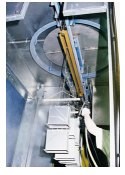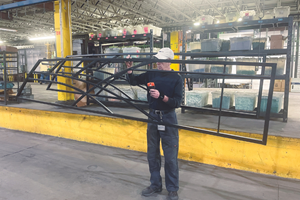Doing Pretreatment Right
This fabricator installed a new pretreatment and powder coating system...
Industrial Fabricators, Inc.,Westerville, Ohio, was founded in 1964 when its current president, Fred Landig, noticed that the city was lacking a job shop fabricator that had the ability to design and manufacture parts. The job shop assembles parts for Lucent Technologies (cellular phone cabinetry), Solid State Control, Inc. (uninterruptible power source cabinetry), Mettler Toledo (frames for check weighing and drum filling equipment) and Leibert Corp. (environmental room equipment).
Since its inception, Industrial Fabricators has used solvent-borne paints to finish parts for its customers. Although it was satisfied with the performance of these solvent-borne paints, the com-pany saw future problems with VOC emissions. With its stack permits already approaching their limits, the company could see that VOCs were going to hinder its business. Industrial Fabricators talked to EPA about obtaining a new stack permit, but EPA discouraged that idea and suggested it try powder coating instead. Also, several of the fabricator's customers stated that in the future they were going to require powder coating on their parts.
The company decided to look into powder coatings as well as waterborne coatings. It also considered adding scrubbers to its stacks. After several years of research, the company decided that powder coating was the way to go. The waterborne coatings were not durable enough, and the scrubbers were too expensive.
About two years ago, the company contacted Dale Dolby at W.C. Grant Co., Inc., Fort Wayne, Indiana. Industrial Fabricators called this complete finishing system installer because it had supplied the company with some ovens a few years earlier. Mr. Dolby was brought in to help the fabricator design its powder coating room and choose its application equipment. Mr. Landig told Mr. Dolby, "We want to talk to you about what we want to do. We are going to depend on your knowledge to get us headed in the right direction." At the same time, the company planned for an addition to its existing building. The addition was designed around the powder coating and pretreatment system with room for assembly and packaging.
Although the supplier was going to design the entire powder coating line, Industrial Fabricators knew that it would sub-contract the construction of the washer. However, instead of spending the money for another fabricator to build its pretreatment system, the company decided to build the system itself.
| TABLE I - Pretreatment Process | |||
| Stage | Chemical | Concentration | Temperature |
| One | Globrite 595 SL, alkaline cleaner |
3% to 4% by volume |
110F |
| Two | Overflowing fresh water rinse |
Ambient | |
| Three | Globrite 595 SL, alkaline cleaner |
4% to 5% by volume |
110F |
| Four | Overflowing fresh water rinse |
Ambient | |
| Five | Sealtex 1449 DI, iron phosphate |
2% to 3% by volume |
110 to 140F |
| Six | Overflowing fresh water rinse |
Ambient | |
| Seven | Sealtex 1523 NCS, non-chromium sealer |
0.25% to 0.5% by volume |
120 to 130F |
Industrial Fabricators called Joe Heitker at Texo Corp., Cincinnati, Ohio, early in the process. Mr. Landig said, "We used Mr. Heitker's knowledge to help us set the design parameters of the washer." Several innovative features were included in the design of the washer. The company decided to put doors, which open and close automatically, between each stage of the washer to prevent cross-contamination of the cleaning solutions. It also put the washer in a pit that was built into the floor of the building. The pit acts as a dike in case of a spill, provides extra room for an additional cleaning tank and allows pollution control equipment to be added to meet future environmental regulations.
Although a five-stage washer would have been adequate, Industrial Fabricators insisted on installing a seven-stage washer (Table I). It wanted to ensure that the parts coming out of the washer were truly clean before they were powder coated. The company constructed the washer out of stainless steel, which has decreased the amount of maintenance required. Industrial Fabricators uses Texo's pretreatment chemicals, which are capable of cleaning ferrous, non-ferrous, aluminum and stainless-steel substrates with one solution. It also installed the chemical supplier's micro-additive system to maintain the proper concentrations in the cleaning tanks on a continual basis.
The first stage of the system is filtered to remove more than 95% of the solids. The soil load is checked before the solution is dumped. In the four months that the system has operated, the solution has been dumped only once. This was done as a precautionary measure rather than out of necessity. Industrial Fabricators had the sludge from the filter analyzed and found that it contained no toxics. Therefore, the sludge is simply dewatered and taken to a landfill. The water from the rest of the system is adjusted to a pH of 5.0 to 12.0 and then dumped into the sewer.
Not only did Industrial Fabricators manufacture its own washer, but it built its own powder spray booth as well. "We wanted to put in a system that would spray to waste because we spray five to seven colors a day. We do not have the time to clean the booth," stated Mr. Landig. The spray booth is located inside an environmental room that was designed along with the new building. The environmental room, which houses the spray booth, also has doors that open and close automatically to help maintain the necessary conditions (70F and 50% humidity). The doors were added instead of an air shield to cut down on energy costs.
The powder coating system is capable of handling any powder that the customer might specify, including any special finishes. The system is capable of matching color and texture to the company's solvent-borne paints. Although the system is quite capable of applying textures to parts, Industrial Fabricators has had a difficult time matching the powder coating texture to the solvent-borne paint texture. This has caused a slight problem for the company, because many of its customers have solvent-borne painted parts still in stock.
The spraying equipment, which consists of box feeders with manual spray guns, was supplied by Wagner Systems, Inc., Glendale Heights, Illinois. The company usually keeps three box feeders ready, each with a different color. This increases the number of color changes possible in one day by eliminating the setup and cleanup time required if only one box feeder was used. All parts are sprayed to a thickness of 1.5 to 2.5 mils. The company found that parts coated with powder were more durable in this range than parts coated with solvent-borne paints. At two mils, solvent-borne coated parts had a salt spray resistance of 700 hours compared to more than 1,000 hours for powder coated parts.
Curing takes place in a three-stage batch-type oven, which is the same oven used for dry-off after pretreatment. In the first stage, the parts are heated and in the second and third stage convection is added. The time each part spends in the oven depends on its mass and weight, but usually varies from 12 to 20 minutes. The oven temperature is automatically controlled and held at a constant 400F. The oven was also designed with automatic doors to cut down on energy costs.
There is virtually no waste treatment required for the powder coating system. A dust collector is attached to the spray booth to collect any powder that does not adhere to the part. To clean the collector, air is back-pulsed through the filter. The room is then cleaned with a vacuum from Vac-U-Max, Belleville, New Jersey. The excess powder is placed in a five-gal bucket and taken to the oven where it is cured and then disposed of.
Because Industrial Fabricators is a proactive company, it researched and planned exactly what it wanted to do. The extra planning time allowed the company to find the most efficient and cost-effective method to avoid future environmental problems. According to Mr. Landig, "We wanted to make sure that it was done right the first time." Had the company waited until it reached the limit on its stack emissions, it would have been forced to make a quick decision. Although that decision may still have resulted in a new powder coating system, it is likely that the system would not have been as efficient and cost effective.
Related Content
Curing Oven Basics
Simply heating up the substrate does not cure the coating. There are many variables to consider when choosing the best cure oven for your application...
Read MoreProducts Finishing Reveals 2023 Qualifying Top Shops
Each year PF conducts its Top Shops Benchmarking Survey, offering shops a tool to better understand their overall performance in the industry. The program also recognizes shops that meet a set of criteria to qualify as Top Shops.
Read MorePowder Coating Overcomes Post Forming
Six Sigma methodology, open communication, and collaboration produce results for leading boat manufacturer.
Read MoreConveyors and Paint Systems
Choosing the right conveyor system, coating technology, and ancillary equipment.
Read MoreRead Next
Education Bringing Cleaning to Machining
Debuting new speakers and cleaning technology content during this half-day workshop co-located with IMTS 2024.
Read MoreDelivering Increased Benefits to Greenhouse Films
Baystar's Borstar technology is helping customers deliver better, more reliable production methods to greenhouse agriculture.
Read MoreEpisode 45: An Interview with Chandler Mancuso, MacDermid Envio Solutions
Chandler Mancuso, technical director with MacDermid Envio discusses updating your wastewater treatment system and implementing materials recycling solutions to increase efficiencies, control costs and reduce environmental impact.
Read More
.JPG;width=70;height=70;mode=crop)











.jpg;maxWidth=300;quality=90)












